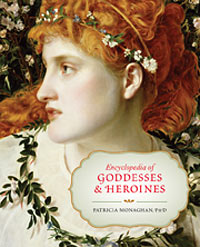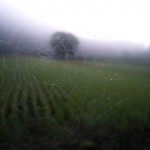When The Red-Haired Girl from the Bog by Patricia Monaghan was published (February 2003) I was working at a bookstore in Seattle, preparing myself for graduate school that fall at Berkeley’s Graduate Theological Union, where I would study feminist and systematic theology. I saw Monaghan’s book at the store and, remembering fondly my own time in Ireland (1996-97), and seeing that she and I had both spent our youth in Alaska, I picked it up. It was a fantastic book, weaving personal narrative, travelogue, and history and mythology of Ireland as seen through feminist and goddess-centered lenses. I loved it. I still have the hard cover edition on my shelf.
 Until her passing in 2012, I had been unaware of Monaghan’s influence in feminist spiritualities or the wealth of works she’d published. It has been a pleasure getting to know about her and her works as I read through her most recent book, which was being prepared for publication during her passing. Monaghan’s Encyclopedia of Goddess & Heroines is a revised and expanded edition of this work. I was not familiar with it before receiving this copy for review.
Until her passing in 2012, I had been unaware of Monaghan’s influence in feminist spiritualities or the wealth of works she’d published. It has been a pleasure getting to know about her and her works as I read through her most recent book, which was being prepared for publication during her passing. Monaghan’s Encyclopedia of Goddess & Heroines is a revised and expanded edition of this work. I was not familiar with it before receiving this copy for review.
I am unreservedly enthusiastic about this book. It’s not one that I can read cover-to-cover like other books. I have read the introduction, several section introductions, and a smattering of entries, some for goddesses I don’t know at all and some for goddesses that I know much better. I was impressed with her discussion of her choice of sources (only hard copy items, nothing digital as access can be unreliable) and her note on spelling. It is no surprise that a scholar and life-long devotee of the divine feminine also has a brilliant paragraph on the word “goddess” as it applies to this book. She talks about the differentiation between goddesses, heroines, semi-divine women, and women who occupy spaces that might be considered divine or magical within monotheism.
Once I’d read the various introductions I looked to her entry on Mary, the Mother of Jesus, to get a sense of her accuracy. I may not be able to gauge how accurate her entries on African deities are, but Mary is my specialty. In approximately 400 words Monaghan succinctly walks the reader through all the high points of Mary’s life, raises some of the issues surrounding her sources, talks about how she is considered in the Islamic tradition, and mentions her feast days. There was not a single sentence I could quibble with. The next entry is on Mary Magdalen, another Mary I know quite a bit about, and here I even learned something new. If this is indicative of the quality of entries in other areas, then I can trust that they are solid introductions to each figure.
While each entry is significantly shorter than a wikipedia entry, each one has a list of sources where you might go to learn more. Sure, I can look up all of these figures online, but for a quick, thoughtful paragraph (or more) to give me an idea of what each Lady is about this is a single handy reference. Myself at 11 would have surely sat and read this entire book and I look forward to using this as a reference for my family. In fact, I wish Monaghan had written something like this for male gods and heroes!
If I had to find something to complain about, it might be the choice of the word “pantheon” for each geographical section. I see what she is doing and it keeps the book consistent, but it doesn’t work very well for areas such as North America, as there weren’t pantheons in quite the same way as we might say there are for the Greeks. Because of the necessary limitations of this project, many regional divine forces were rleft out, entities that might be more related to land and place. I was also surprised by Santisima Muerte’s absence. Perhaps Monaghan viewed her as more of an aberation of Roman Catholic saints, but I believe she is a divine figure in her own right.
Overall this is a fantastic reference book that is worth the cover price ($29.95). I am pleased to have this on my shelf. I know I will use it often, and when I do I will think fondly of Monaghan’s work. This edition is truly the work of a lifetime.











